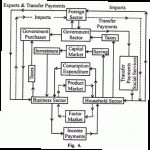
For example, net profit margin, often referred to simply as profit margin or the bottom line, is a ratio that investors use to compare the profitability of companies within the same sector. It’s calculated by dividing a company’s net income by its revenues and is often used instead of dissecting financial statements to compare how profitable companies are. Investors and analysts use ratio analysis to evaluate the financial health of companies by scrutinizing past and current financial statements. For example, comparing the price per share to earnings per share allows investors to find the price-to-earnings (P/E) ratio, a key metric for determining the value of a company’s stock. Liquidity ratio measures quickbooks payroll review a company’s ability to pay off short-term liabilities with current assets like cash and equivalents, accounts receivable and inventory.
However, they are more than just numbers to help understand their stability. Ratios can be used for macro-level analysis, but in-depth research needs to understand the business properly. The goal may be to hold current levels steady or to strive for operational growth. For example, a company’s existing current ratio may be 1.1; if the company wants to become more liquid, it may set the internal target of having a current ratio of 1.2 by the end of the fiscal year. There are many different ratios that investors and other business experts can analyze to make predictions about a company’s financial stability and potential future growth.
Types of Accounting Ratios
These ratios are helpful for all stakeholders who seek to understand a company’s profitability and health. Accounting ratios tell you many different pieces of financial information about your company, such as whether it has accumulated too much debt or has too much inventory. Financial statements tell the story of financial health through various metrics, such as cash flow, liquidity, and profit and loss. To obtain your profit margin ratio, start with your revenue, which is $25,000. Then subtract your total expenses, which amount to $18,500, which leaves a total of $6,500.
Why Is Ratio Analysis Important?
An accounting ratio compares two line items in a company’s financial statements. These consist of its income statement, balance sheet, and cash flow statement. The ratios can be used to evaluate a company’s fundamentals and provide information about the performance of the company over the last quarter or fiscal year. In the concept of financial accounting ratios two items taken from the financial statements of the organization’s balance sheet is compared with each other in the form of ratio analysis. The result is expressed as a number or a percentage and compared with simiral ratios of the past data premium on stock important points related to premium on stock to evaluate the company performance.
- Then, a company can explore the reasons certain months lagged or why certain months exceeded expectations.
- Sometimes called the gross profit margin ratio, it compares the gross margin of a company to its revenue.
- The Debt Ratio measures the liabilities in comparison to the assets of the company.
- Therefore, it is useful for inventory reordering and understanding the conversion cycle.
- For example, net profit margin, often referred to simply as profit margin or the bottom line, is a ratio that investors use to compare the profitability of companies within the same sector.
They paint a picture of where a company came from, how they are doing currently, and where they are going into the future. The ratios may seem simple at first, but they are incredibly nuanced and can be difficult to calculate once one is attempting to analyze and quantify Fortune 500 companies. Often, accounting ratios are calculated yearly or quarterly, and different ratios are more important to different industries. For example, the inventory turnover ratio would be significantly important to a retailer but with almost no significance to a boutique advisory firm.
Great! The Financial Professional Will Get Back To You Soon.
A savvy investor knows how to use accounting ratios to determine whether a stock presents a lucrative opportunity or perhaps a liability that other investors have yet to realize. Sure, your accounting software will automatically calculate and track all your ratios. But that’s only meaningful when you understand what these ratios signify for your business. Remembering ratios and formulas can feel overwhelming, but you don’t have to memorize them — just understand them. Keep it handy as you look at your accounting software to help you truly see your company’s complete financial picture. Financial statements such as income statements and balance sheets are of limited value as sources of information.

It indicates how much of shareholders’ funds are invested in the assets. The Debt Ratio measures the liabilities in comparison to quickbooks undeposited funds account explained the assets of the company. The operating ratio expresses the relationship between operating costs and net sales.
Consider the inventory turnover ratio that measures how quickly a company converts inventory to a sale. A company can track its inventory turnover over a full calendar year to see how quickly it converted goods to cash each month. Then, a company can explore the reasons certain months lagged or why certain months exceeded expectations.



